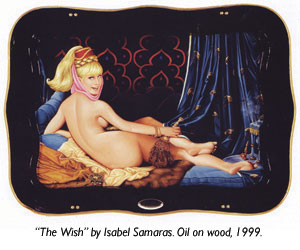Its a Mad, Mad, Mad, Mad World
Pop culture and classical painting meet in the surreal land of lowbrow art

Weirdo Deluxe: The Wild World of Pop Surrealism and Lowbrow Art
By Matt Dukes Jordan
Chronicle, $24.95
We are not, it’s safe to say, living in a golden age of representational painting. Since abstract expressionism shot American fine art onto the international map, the visual-art vanguard has been mostly concerned with philosophy and provocativeness, leaving portraiture to fashion photographers and consigning still-lifes and landscapes to anonymous motel-room watercolorists.
All of which makes the movement known variously as lowbrow or pop surrealism particularly compelling. Its influences range all over an admittedly modern map—MAD and other underground comix, ’60s tiki and hot rod culture, TV, punk rock, porn and pulp, to name just a few. But underneath the pop-obsessed veneer, lowbrow is paradoxically and profoundly old-fashioned, owing just as much to Grand Guignol grotesquerie and to the visceral weirdness of figurative-painting masters like Breughel, Reubens and Bosch. In short, it’s as close as American fine art’s gotten in quite some time to having a truly interesting representational branch. With Weirdo Deluxe, the genre gets exactly the kind of anthology it deserves—accessible and agreeably bizarre, with the artists given free rein to speak for themselves. And what’s more, the anthology captures both the vast range of the lowbrow movement and its common threads.
Those common threads are the most immediately noticeable thing here—aggressively bright colors, attention to pop-cultural detail, heavy focus on the body in all its glory and grossness. But a closer look reveals how far many of these artists go in different directions from that home base. There are guys like Joe Coleman, who paints fanatically detailed works in oil, usually featuring a figure in the center, surrounded, cabinet-of-curiosities-style, by the visual and textual detritus of their life. (Coleman, it should be noted, also has a museum in his home called the Odditorium. An alarming number of lowbrow artists, in fact, have collections of mid-century detritus.) But just as Coleman’s style has influenced a veritable school of “busier” lowbrow artists, so do elements of the equally bright but more minimal work of Gary Panter show up throughout Weirdo Deluxe, especially in the Dalí-meets-Tex-Avery art of younger up-and-comers like Anthony Ausgang and Kathy Staico Schorr. (While we’re doing fun facts: Panter designed the sets for Pee-Wee’s Playhouse, way back when. How he got into primitivism is anyone’s guess.)
Then there’s the stuff that’s less directly connected—Isabel Samaras’s Manet-like portraits of characters from 1960s sitcoms; Mark Ryden’s creepy pastel renderings of troubled-looking young girls; Josh “Shag” Agle’s L.A.-fabulous paintings that look for all the world like old Jim Flora album covers; Tim Biskup’s work, which is probably the most abstract here, and which appears to be inspired by nightmares involving the credit sequences of Chuck Jones-era Looney Tunes. The list goes on, the point being that, despite the common ground these artists share, there’s still something surprising on damn near every page.
Weirdo Deluxe author/curator Matt Dukes Jordan is clearly a longtime fan of lowbrow, and thus the book is suffused with an appreciation for the genre’s history. A useful introduction and timeline situate the form neatly among American art and culture. In addition to the section on Panter, there is a treatement of Gary Baseman, the most conventionally successful lowbrow artist (ever played Cranium or seen the Disney cartoon Teacher’s Pet? Then you’ve seen his work). And Jordan also features Robert Williams, who worked as a car customizer with the legendary Ed “Big Daddy” Roth, and who’s largely considered the father of lowbrow. (For good reason—any single one of Williams’s oil paintings contains virtually everything listed above as a major part of the genre.) And Williams himself sums up the old-meets-new vibe of lowbrow pretty succinctly in discussing one of his own key influences: “MAD comic books had the term ‘mad’ in the title for a reason. They would overload the picture panels so that you had this feeling of uncontrollable chaos … There had never been anything like that. Maybe Hieronymous Bosch.”
And that, pretty much, is lowbrow art come full circle: from Bosch to Bewitched in a bright purple 1932 Ford coupe, with stops at Vegas, Haight-Ashbury, and the Jetsons’ pad along the way. So if you’re left a little cold by the Thomas Kinkade cottages and celebrity glossies that are passing for decent figurative art these days, dive into this garden of earthly delights. You won’t be disappointed.
To read more book reviews, visit Ruminator’s web site www.ruminator.com